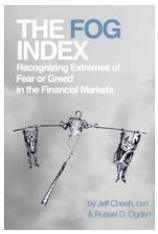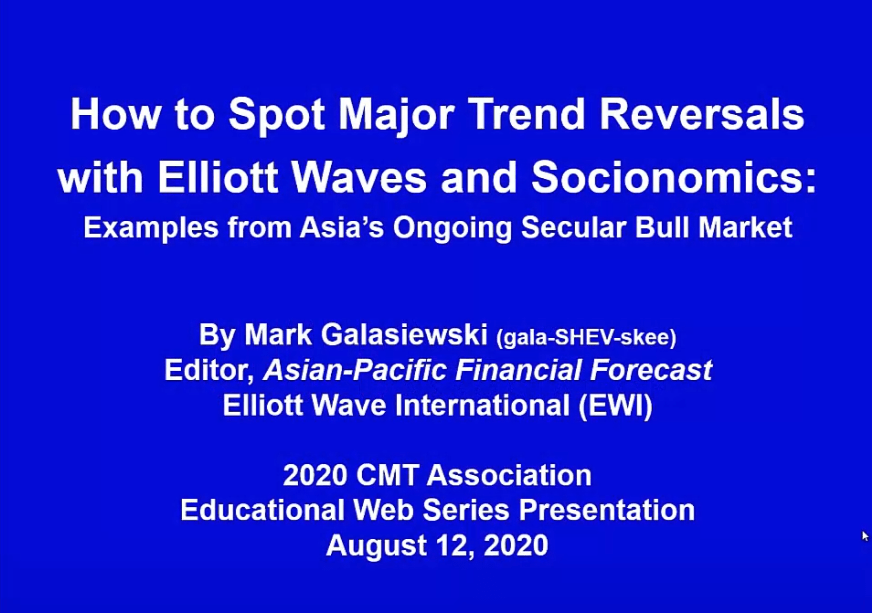 Letter from the Editor
Letter from the Editor
In this month’s issue of Technically Speaking, we offer several short articles that could stimulate some fresh thoughts on the markets.
John R. McGinley, CMT, offers details on a reliable January indicator. What is interesting about his work is that he includes a test of statistical significance, a step lacking in most articles written about technical indicators. We are also reprinting a very readable explanation of the chi squared test written John’s friend and mentor, the late Arthur Merrill, CMT.
We follow this with some very specific trading lessons. Mike Moody, CMT, quantifies how much following a disciplined approach can be worth in “The $ Value of Patience.” Ken Winans, CMT, contributes an article which shows that simple strategies can work very well. David Penn of TradingMarkets.com also explains a specific trading strategy. Bob Palmerton, CMT, provides details on a disciplined way to look at the markets each day.
Finally, we have some reviews of trading tools developed by MTA members. We are always happy to bring your work to the attention of
To view this content you must be an active member of the TAN Association.
Not a member? Join the TAN Association and unlock access to hundreds of hours of written and video technical analysis content, including the Journal of Technical Analysis and the Video Archives. Learn more about Membership here.
What's Inside...
World’s Best January Indicator
by John R. McGinley, CMT(If the 1st five days are net up, the year will be up. If down, no prediction, a coin-toss) This is hands-down THE best of the January Indicators. This year for only the second time in six years, the...
Chi Squared
by Arthur Merrill, CMTEditor’s Note: Arthur Merrill, CMT, was a leading advocate of the need to apply statistical rigor to technical analysis methods. He frequently employed the Chi squared test to assess the validity...
The $ Value of Patience
by Mike Moody, CMTThis article was originally published at Systemic Relative Strength, the official blog of Dorsey Wright Money Management on January 6, 2010. It is reprinted here with permission. Additional articles...
Buy and Hold Investing: Bonds-Yes & Stocks-No!
by Ken Winans, CMTEvery bull market produces its fair share of “proven” investment strategies that promise easy riches. During the “Roaring 1920’s”, buying equities with high levels of margin debt was...
Moving Averages: ETF Strategies for Short Term Traders
by David PennWhat are the two most important moving averages for short-term, high probability ETF traders? Moving averages are a very popular tool, and are a key ingredient in many trading strategies. Moving...
Baseline Analytics’ Market Tour
by Robert F. Palmerton, Jr., CMTAt the close of each trading day, Baseline Analytics conducts a streamlined yet comprehensive review of the financial markets. To short-cut the time spent reviewing the markets without compromising...
Fibozachi – Taking the Trading World by Storm
by Deberah BringelsonThe first thing you’ll want to know is were the name comes from. Fibozachi is a combination of the words Fibonacci and Zachary. Fibozachi.com is the creation of two brothers who combined...
The FOG Index: Recognizing Extremes of Fear and Greed in the Financial Markets by Jeff Cheah, CMT, and Russel D. Ogden
by Jeff Cheah & Russel D. Ogden & Michael Carr, CMTIn a short book about 80 pages in length, Cheah and Ogden introduce the FOG Index, an indicator offered exclusively to subscribers of Thomson Reuters’ DataStream and 3000 Xtra products. However,...
MTA Announcements
MTA Website Orientation Video – New! Over the course of the last month the MTA has gone through the process of creating an orientation video for our mta.org website. The purpose of this video...
(If the 1st five days are net up, the year will be up. If down, no prediction, a coin-toss)
This is hands-down THE best of the January Indicators. This year for only the second time in six years, the first five trading days of January were up (1.8%); therefore we have a buy signal for the year as a whole. We record a buy signal only when the first five days are up. There are no sell signals because when the first five days are down, the record amounts to a coin-toss. The same applies to the month of January as a whole (i.e. do not use the down months), but the record is not as great as for the first five; further, waiting until Feb 1 to buy can amount to missing as much as 15% of a year’s move. The extraordinary statistics of this indicator are found below. We
To view this content you must be an active member of the TAN Association.
Not a member? Join the TAN Association and unlock access to hundreds of hours of written and video technical analysis content, including the Journal of Technical Analysis and the Video Archives. Learn more about Membership here.
Contributor(s)

John R. McGinley, CMT
John R. McGinley, CMT is Editor of TECHNICAL TRENDS, the Indicator Accuracy Service. For more information, please contact John at jmcgoo@post.harvard.edu or
Editor’s Note: Arthur Merrill, CMT, was a leading advocate of the need to apply statistical rigor to technical analysis methods. He frequently employed the Chi squared test to assess the validity of his backtested results. This difficult concept is usually explained over the course of several dozen pages in college-level statistics textbooks. Demonstrating his extraordinary ability to make the complex simple, Art published this concise and understandable explanation in his newsletter in August 1986:
If, in the past, the records show that the market behavior exhibited more rises than declines at a certain time, could it have been by chance? Yes. If a medication produced cures more often than average, could it have been luck? Yes.
If so, how meaningful is the record?
To be helpful, statisticians set up “confidence levels.” If the result could have occurred by chance once in twenty repetitions of the record, you can have 95% confidence that the
To view this content you must be an active member of the TAN Association.
Not a member? Join the TAN Association and unlock access to hundreds of hours of written and video technical analysis content, including the Journal of Technical Analysis and the Video Archives. Learn more about Membership here.
Contributor(s)

Arthur Merrill, CMT
Bio
This article was originally published at Systemic Relative Strength, the official blog of Dorsey Wright Money Management on January 6, 2010. It is reprinted here with permission. Additional articles can be found at http://systematicrelativestrength.com/
The annals of investor behavior make for some pretty scary reading. Yet this story from the Wall Street Journal may take the cake. It is an article about the top-performing mutual fund of the decade and it shows with remarkable clarity how badly investors butcher their long-term returns. The article hits the premise right up front:
Meet the decade’s best-performing U.S. diversified stock mutual fund: Ken Heebner’s $3.7 billion CGM Focus Fund, which rose more than 18% annually and outpaced its closest rival by more than three percentage points. Too bad investors weren’t around to enjoy much of those gains. The typical CGM Focus shareholder lost 11% annually in the 10 years ending Nov. 30, according to investment
To view this content you must be an active member of the TAN Association.
Not a member? Join the TAN Association and unlock access to hundreds of hours of written and video technical analysis content, including the Journal of Technical Analysis and the Video Archives. Learn more about Membership here.
Contributor(s)

Mike Moody, CMT
Mike Moody is a Senior Portfolio Manager at Dorsey, Wright Money Management. He joined the firm in 1994. Prior to Dorsey Wright, he worked for Smith Barney and Merrill Lynch. Mr. Moody has been a speaker on the subject of technical analysis and has provided commentary for...
Every bull market produces its fair share of “proven” investment strategies that promise easy riches.
During the “Roaring 1920’s”, buying equities with high levels of margin debt was the norm among everyday investors. During the mega bull market from 1982 – 2000, it was the notion of buying & holding equity index funds at all times that became the cornerstone strategy for many investors, big and small alike. Unfortunately, both strategies led investors off a financial cliff during the next bear market!
In the following table, Winans International completed a study that compared 3 different equity investment strategies using S&P 500 Index funds from 1988 to 2009. Two different scenarios were analyzed. One in which all capital was invested at once (i.e., beginning lump sum investment), and the other of building up a portfolio gradually by investing $500 per month (i.e., dollar cost averaging). 90-day Tbills and corporate bond investments with laddered
To view this content you must be an active member of the TAN Association.
Not a member? Join the TAN Association and unlock access to hundreds of hours of written and video technical analysis content, including the Journal of Technical Analysis and the Video Archives. Learn more about Membership here.
Contributor(s)

Ken Winans, CMT
Ken Winans, CMT President & Founder, Winans Investments For 28 years, Ken Winans, CMT, has conducted groundbreaking financial research within the discipline of technical analysis while serving as a portfolio manager, investment analyst, broker and investor. Ken is the...
What are the two most important moving averages for short-term, high probability ETF traders?
Moving averages are a very popular tool, and are a key ingredient in many trading strategies. Moving averages are typically trend-following tools that help traders determine what kind of trend, if any, a given market has developed.
One problem with moving averages is that many of the uses of moving averages have not been quantified – especially for short term traders in stocks and ETFs. As a result, a number of short term trading strategies for stock and ETFs that rely on moving averages or even multiple moving averages, have often underperformed. Our research into short term price behavior – in both stocks and ETFs – has found two key roles for moving averages in our trading strategies. These roles enable us to use moving averages for what they are best equipped to do – at least from
To view this content you must be an active member of the TAN Association.
Not a member? Join the TAN Association and unlock access to hundreds of hours of written and video technical analysis content, including the Journal of Technical Analysis and the Video Archives. Learn more about Membership here.
Contributor(s)

David Penn
David Penn is Senior Editor at
At the close of each trading day, Baseline Analytics conducts a streamlined yet comprehensive review of the
financial markets. To short-cut the time spent reviewing the markets without compromising the key market
indicators we have found to be most important to arrive at a trading strategy, Baseline Analytics has devised a
daily “Market Tour” consisting of about 30 charts made public and maintained on Stockcharts.com. These
charts are organized into several categories:
- Index reviews
- Market Breadth
- Sentiment
- Sector relative strength
- Intermarket (bonds, commodities, stocks)
- Style (small cap, large cap, value and growth)
The charts are annotated with comments and colored based on bullish perspective (green), bearish (red), and
neutral (black). Here is how our daily Market Tour begins:
Index Reviews: The Big Picture:
Our nightly tour starts with a price review of the major indices (the focus is on one daily and weekly chart each
of the S&P500 and the Nasdaq); observing price behavior relative to trendlines (with a
To view this content you must be an active member of the TAN Association.
Not a member? Join the TAN Association and unlock access to hundreds of hours of written and video technical analysis content, including the Journal of Technical Analysis and the Video Archives. Learn more about Membership here.
Contributor(s)

Robert F. Palmerton, Jr., CMT
Robert F. Palmerton, Jr., CMT, has over 25 years’ experience in corporate finance. He has held positions as CFO, Director of Finance, and Financial Management and Analysis roles for Fortune 500 and multi-national firms (ADP, Honeywell, BOC Group) as well as for early-stage and...
The first thing you’ll want to know is were the name comes from. Fibozachi is a combination of the words Fibonacci and Zachary. Fibozachi.com is the creation of two brothers who combined overlapping expertise in the field of technical analysis. One brother is a portfolio manager with a macro outlook and the other is a trader with a micro outlook. One has a BA in Economic History and a Concentration in Economic Game Theory from the University of Pennsylvania, while the other has a BA in Psychology from the University of Colorado at Boulder; each is a candidate for Level III of the Chartered Market Technician designation.
Bursting onto the trading scene in early – 2009; Fibozachi, with its highly accurate and innovative indicators is taking the trading world by storm. The Brothers Fibozachi; Zachary and Brandon have combined extremely high level fractals and mathematical formulas and the harmonic rhythms of
To view this content you must be an active member of the TAN Association.
Not a member? Join the TAN Association and unlock access to hundreds of hours of written and video technical analysis content, including the Journal of Technical Analysis and the Video Archives. Learn more about Membership here.
Contributor(s)

Deberah Bringelson
Former Silicon Valley CEO, Deberah Bringelson is a three time Most Influential Woman in Business honoree. She is best known for receiving the prestigious "Steal of The Year" award for negotiating the deal between Sir Richard Branson’s Virgin America and California Governor...

In a short book about 80 pages in length, Cheah and Ogden introduce the FOG Index, an indicator offered exclusively to subscribers of Thomson Reuters’ DataStream and 3000 Xtra products. However, the book is far from being a marketing brochure for a proprietary technical tool. It is an interesting and instructive look at how many other technical indicators can be evaluated. In less than an hour, readers will understand that there may be more information in the first derivative of an oscillator than in the oscillator itself. With this inspiration, some readers may find success by applying the general principles that the authors detail in The FOG Index.
The authors explain that, “The FOG Index is a tool to help market participants recognize extremes of fear or greed in the financial markets. It helps to spot the early warning signs of euphoria heading
To view this content you must be an active member of the TAN Association.
Not a member? Join the TAN Association and unlock access to hundreds of hours of written and video technical analysis content, including the Journal of Technical Analysis and the Video Archives. Learn more about Membership here.
Contributor(s)

Jeff Cheah
Jeff Cheah, who holds a Chartered Market Technician (CMT) designation, is a Market Risk and Capital Markets Treasury professional at IAMGOLD. Previously, he was with Maple Leaf Foods as a Risk Manager and AIP Private Capital as an Economic Advisor, as well as serving as the...

Russel D. Ogden
Russel Ogden is a sociologist at Kwantlen Polytechnic University, Surrey, British

Michael Carr, CMT
Mike Carr, who holds a Chartered Market Technician (CMT) designation, is a full-time trader and contributing editor for Banyan Hill Publishing, a leading investment newsletter service. He is an instructor at the New York Institute of Finance and a contributor to various...
MTA Website Orientation Video – New!
Over the course of the last month the MTA has gone through the process of creating an orientation video for our mta.org website. The purpose of this video is to provide new and prospective members with a tutorial that explains and describes how to access all the member services that are offered through our website. As an existing member, if you are unsure or would like a “refresher” on what is available through our website, this video might be of value to you. Click here to view this new orientation video.
MTA Board of Directors Nominations
For the fiscal year commencing July 1, 2010, four (4) Officer positions are up for consideration for a 2-year term, and two (2) At-large Board positions are up for consideration for a 3-year term. Over the next two months, we are encouraging any Member, Honorary Member or Emeritus Member
To view this content you must be an active member of the TAN Association.
Not a member? Join the TAN Association and unlock access to hundreds of hours of written and video technical analysis content, including the Journal of Technical Analysis and the Video Archives. Learn more about Membership here.
New Educational Content This Month
-
August 26, 2020
The CMT Experience
Presenter(s): Tyler Wood, Dave Lundgren, CMT, CFA
-
August 26, 2020
Reading the Current Market in Light of History’s Lessons
Presenter(s): Ryan Detrick, CMT
-
August 12, 2020
How to Spot Major Trend Reversals with Elliott Waves and Socionomics: Examples from Asia’s Ongoing Secular Bull Market
Presenter(s): Mark Galasiewski



